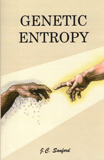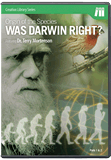
Chapter 2
Are Mutations Part of the “Engine” of Evolution?
Let’s look at mutations in more detail and see if they provide the information necessary to support pond-scum-to-people evolution, or if they confirm God’s Word in Genesis.
In the evolutionary model, mutations are hailed as a dominant mechanism for pond-scum-to-people evolution and provide “proof ” that the Bible’s history about creation is wrong. But are we to trust the ideas of imperfect, fallible men about how we came into existence, or should we believe the account of a perfect God who was an eyewitness to His creation? Let’s look at mutations in more detail and see if they provide the information necessary to support pond-scum-to-people evolution, or if they confirm God’s Word in Genesis.
Mutations are primarily permanent changes in the DNA strand.
Mutations are primarily permanent changes in the DNA strand. DNA (deoxyribonucleic acid) is the information storage unit for all organisms, including humans, cats, and dogs. In humans, the DNA consists of about three billion base pairs. The DNA is made of two strands and forms a double helix. In sexual reproduction, one set of chromosomes (large segments of DNA) comes from the mother and one set from the father. In asexual reproduction, the DNA is copied whole and then passed along when the organism splits.
The double helix is made up of four types of nitrogen bases called nucleotides. These types are guanine, cytosine, adenine, and thymine. They are represented by the letters G, C, A, and T. Each of these base pairs, or “letters,” is part of a code that stores information for hair color, height, eye shape, etc. The bases pair up as follows: adenine to thymine and guanine to cytosine.
| A •- | N -• | 0 ----- |
| B -••• | O --- | 1 •---- |
| C -•-• | P •--• | 2 ••--- |
| D -•• | Q --•- | 3 •••-- |
| E • | R •-• | 4 ••••- |
| F ••-• | S ••• | 5 ••••• |
| G --• | T - | 6 -•••• |
| H •••• | U ••- | 7 --••• |
| I •• | V •••- | 8 ---•• |
| J •--- | W •-- | 9 ----• |
| K -•- | X -••- | Fullstop •-•-•- |
| L •-•• | Y -•-- | Comma --••-- |
| M -- | Z --•• | Query ••--•• |
Think of it like Morse code. Morse code is a system in which letters are represented by dashes and dots (if audible, then it is a long sound and short sound). When you combine different dots and dashes, you can spell out letters and words. Here is a copy of Morse code:
If someone wanted to call for help using Morse code, for instance, he or she would send the letters SOS (which is the international distress signal). Morse code for SOS is:
S is dot dot dot [• • •] or three short sounds.
O is dash dash dash [– – –] or three long sounds.
S is dot dot dot [• • •] or three short sounds.
Therefore, it would be [• • • – – – • • •], or three short sounds followed by three long sounds, followed by three short sounds.
A mutation would be like changing a dot to a dash in Morse code. If we tried to spell SOS in Morse code, but changed the first dot to a dash, it would accidentally read:
[– • • – – – • • •]
Dash dot dot is the sequence for D, not S; so it would now read:
D [– • •]
O [– – –]
S [• • •]
So, because of the mistake (mutation), we now read DOS, instead of SOS. If you sent this, no one would think you needed help. This mutation was significant because it did two things to your message:
- The original word was lost.
- The intent/meaning was lost.
The DNA strand is similar to, but much more complicated than, Morse code. It uses four letters (G, A, T, C) instead of dashes and dots to make words and phrases. And like Morse code, mutations can affect the DNA strand and cause problems for the organism. These DNA mistakes are called genetic mutations.
- Loss of information1
- Gain of new information
Virtually all observed mutations are in the category of loss of information. This is different from loss or gain of function. Some mutations can cause an organism to lose genetic information and yet gain some type of function. This is rare but has happened. These types of mutations have a beneficial outcome. For example, if a beetle loses the information to make a wing on a windy island, the mutation is beneficial because the beetle doesn’t get blown out to sea and killed. Genetically, the mutation caused a loss of information but was helpful to the beetle. Thus, it was a beneficial outcome.
Besides mutations that cause information loss, in theory there could also be mutations that cause a gain of new information. There are only a few alleged cases of such mutations. However, if a mutated DNA strand were built up with a group of base pairs that didn’t do anything, this strand wouldn’t be useful. Therefore, to be useful to an organism, a mutation that has a gain of new information must also cause a gain of new function.
Types of Genetic Mutations
The DNA strand contains instructions on how to make proteins. Every three “letters” code for a specific amino acid, such as TGC, ATC, GAT, TAG, and CTC. Many amino acids together compose a protein. For simplicity’s sake, to illustrate concepts with the DNA strand, we will use examples in English. Here is a segment illustrating DNA in three-letter words:
The car was red. The red car had one key.
The key has one eye and one tip.
Point Mutations
Point mutations are mutations where one letter changes on the DNA sequence. A point mutation in our example could cause “car” in the second sentence to be read “cat”:
The car was red. The red cat had one key.
The key has one eye and one tip.
With this point mutation, we lost the information for one word (car) as well as changed the meaning of the sentence. We did gain one word (cat), but we lost one word (car) and lost the meaning of one phrase. So the overall result was a loss of information.
But many times, point mutations won’t produce another word. Take for instance another point mutation, which changes “car” not to “cat” but to “caa”:
The car was red. The red caa had one key.
The key has one eye and one tip.
With this point mutation, we lost the information for one word (car) as well as the meaning. We did not gain any new words, and we lost one word and lost the meaning of one phrase. So again, the overall result of this point mutation was a loss of information, but even more so this time.
Point mutations can be very devastating. There is a children’s disease called Hutchinson-Gilford progeria syndrome (HGPS), or simply progeria. It was recently linked to a single point mutation. It is a mutation that causes children’s skin to age, their head to go bald at a very early age (prekindergarten), their bones to develop problems usually associated with the elderly, and their body size to remain very short (about one-half to two-thirds of normal height). Their body parts, including organs, age rapidly, which usually causes death at the average age of 13 years.2
Not all point mutations are as devastating, yet they still result in a loss of information. According to biophysicist Lee Spetner, “All point mutations that have been studied on the molecular level turn out to reduce the genetic information and not to increase it.”3
Inversion Mutations
An inversion mutation is a segment of DNA in a particular strand that reverses itself. An inversion mutation would be like taking the second sentence of our example and spelling it backwards:
The car was red. Yek eno dah rac der eht.
The key has one eye and one tip.
With inversion mutations, we can lose quite a bit of information. We lost several words from, and the meaning of, the second sentence. These mutations can cause serious problems to the organism. The bleeding disorder hemophilia A is caused by an inversion in the Factor VIII (F8) gene.
Insertion Mutations
An insertion mutation is a segment of DNA, whether a single base pair or an extensive length, that is inserted into the DNA strand. For this example, let’s copy a word from the second sentence and insert it into the third sentence:
The car was red. The red car had one key.
Had the key has one eye and one tip.
This insertion really didn’t help anything. In fact, the insertion is detrimental to the third sentence in that it makes the third sentence meaningless. So this copied word in the third sentence destroyed the combined meanings of the eight words in the third sentence. Insertions generally result in a protein that loses function.4
Deletion Mutations
A deletion mutation is a segment of DNA, whether a single base pair or an extensive length, that is deleted from the strand. This will be an obvious loss. In this instance, the second sentence will be deleted.
The car was red. The key has one eye and one tip.
The entire second sentence has been lost. Thus, we have lost its meaning as well as the words that were in the sentence. Some disorders from deletion mutations are facioscapulohumeral muscular dystrophy (FSHD) and spinal muscular atrophy.5
Frame Shift Mutations
There are two basic types of frame shift mutations: frame shift due to an insertion and frame shift due to a deletion. These mutations can be caused by an insertion or deletion of one or more letters not divisible by three, which causes an offset in the reading of the “letters” of the DNA.
If a mutation occurs where one or more letters are inserted, then the entire sentence can be off. If a t were inserted at the beginning of the second sentence, it would read like this:
The car was red. Tth ere dca rha don eke yth
eke yha son eey ean don eti p.
Four new words were produced (two of them twice): ere, don, eke and son. These 4 words were not part of the original phrase. However, we lost 14 words. Not only did we lose these words, but we also lost the meaning behind the words. We lost 14 words while gaining only 4 new ones.
Therefore, even though the DNA strand became longer and produced 4 words via a single insertion, it lost 14 other words. The overall effect was a loss of information.
A frame shift mutation can also occur by the deletion of one or more “letters.” If the first t in the second sentence is deleted, the letters shift to the left, and we get:
The car was red. Her edc arh ado nek eyt hek
eyh aso nee yea ndo net ip.
Five new words were produced: her, ado, nee, yea, and net. However, once again, we lost 14 words. So again, the overall effect was a loss of information, and the DNA strand became smaller due to this mutation.
Frame shift mutations are usually detrimental to the organism by causing the resulting protein to be nonfunctional.
This is just the basics of mutations at a genetic level.6
What Does Evolution Teach about Mutations?
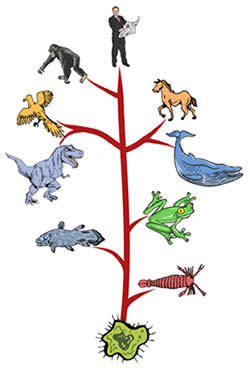
Pond-scum-to-people evolution teaches that, over time, by natural causes, nonliving chemicals gave rise to a living cell. Then, this single-celled life form gave rise to more advanced life forms. In essence, over millions of years, increases in information caused by mutations plus natural selection developed all the life forms we see on earth today.
For molecules-to-man evolution to happen, there needs to be a gain in new information within the organism’s genetic material. For instance, for a single-celled organism, such as an amoeba, to evolve into something like a cow, new information (not random base pairs, but complex and ordered DNA) would need to develop over time that would code for ears, lungs, brain, legs, etc.
If an amoeba were to make a change like this, the DNA would need to mutate new information. (Currently, an amoeba has limited genetic information, such as the information for protoplasm.) This increase of new information would need to continue in order for a heart, kidneys, etc., to develop. If a DNA strand gets larger due to a mutation, but the sequence doesn’t code for anything (e.g., it doesn’t contain information for working lungs, heart, etc.), then the amount of DNA added is useless and would be more of a hindrance than a help.
There have been a few arguable cases of information-gaining mutations, but for evolution to be true, there would need to be billions of them. The fact is, we don’t observe this in nature, but rather we see the opposite—organisms losing information. Organisms are changing, but the change is in the wrong direction! How can losses of information add up to a gain?
What Does the Bible Teach?
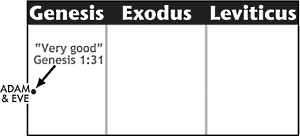
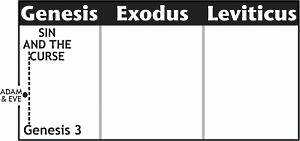
From a biblical perspective, we know that Adam and Eve had perfect DNA because God declared all that He had made “very good” (Genesis 1:31). This goes for the original animal and plant kinds as well. They originally had perfect DNA strands with no mistakes or mutations.
However, when man sinned against God (Genesis 3), God cursed the ground and the animals, and He sentenced man to die (Genesis 2:17; 3:19). At this time, God seemed to withdraw some of His sustaining power to no longer completely uphold everything in a perfect state.
Since then, we would expect mutations to occur and DNA flaws to accumulate. The incredible amount of information that was originally in the DNA has been filtered out, and in many cases lost, due to mutations and natural selection.
At the time of Noah’s flood, there was a genetic bottleneck where information was lost among many land animals and humans. The only genetic information that survived came from the representatives of the kinds of landdwelling, air-breathing animals and humans that were on the ark.


Over time, as people increased on the earth, God knew that mutations were rising within the human population and declared that people should no longer intermarry with close relatives (Leviticus 18). Why did He do this? Intermarriage with close relatives results in the possibility of similar genetic mutations appearing in a child due to inheriting a common mutation from both the father and mother. If both parents inherited the same mutated gene from a common ancestor (e.g., a grandparent), this would increase the possibility of both parents passing this mutated gene along to their child.
Marrying someone who is not a close relative reduces the chances that both would have the same mutated gene. If the segment of DNA from the mother had a mutation, it would be masked by the father’s unmutated gene. If the segment of DNA from the father had a mutation, it would be masked by the mother’s unmutated gene. If the genes from both parents were mutated, then the mutation would show in the child.7 Our all-knowing God obviously knew this would happen and gave the command in Leviticus not to marry close relations.
Conclusion
The biblical perspective on change within living things doesn’t require that new information be added to the genome as pond-scum-to-people evolution does. In fact, we expect to see the opposite (loss of genetic information) due to the curse in Genesis 3. Biblically, we would expect mutations to produce defects in the genome and would not expect mutations to be adding much, if any, new information.
Observations confirm that mutations overwhelmingly cause a loss of information, not a net gain, as evolution requires.
Mutations, when properly understood, are an excellent example of science confirming the Bible. When one sees the devastating effects of mutations, one can’t help but be reminded of the curse in Genesis 3. The accumulation of mutations from generation to generation is due to man’s sin. But those who have placed their faith in Christ, our Creator, look forward to a new heaven and earth where there will be no more pain, death, or disease.
The New Answers Book 2
In The New Answers Book 2 you’ll find 31 more great answers to big questions for the Christian life.
Read Online Buy BookFootnotes
- For a definition of information that is based on the laws of science, see W. Gitt, In the Beginning Was Information (Green Forest, AR: Master Books, 2006).
- B. Hodge, “One Tiny Flaw and 50 Years Lost,” Creation 27(1) (2004): 33.
- L. Spetner, Not by Chance (New York: Judaica Press, 1997), p. 138.
- DNA Direct website, www.dnadirect.com.
- Athena Diagnostics website, http://neurolink.athenadiagnostics.com/facioscapulohumeral-muscular-dystrophy-genetic-overview-and-recent-advancements/ https://www.athenadiagnostics.com/view-full-catalog/a/atypical-spinal-muscular-atrophy-advanced-sequenci.
- For more on specific mutations and more complex examples, please visit www.AnswersInGenesis.org/mutations.
- This is only true for recessive mutations like the one that causes cystic fibrosis. There are some dominant mutations that will appear in the child regardless of having a normal copy of the gene from one parent.
Recommended Resources

Answers in Genesis is an apologetics ministry, dedicated to helping Christians defend their faith and proclaim the good news of Jesus Christ.
- Customer Service 800.778.3390
- © 2024 Answers in Genesis


